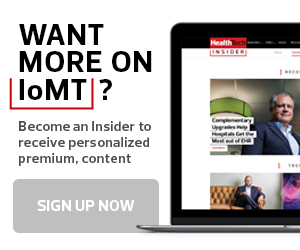A connected infrastructure of medical devices, software applications and health systems and services, the Internet of Medical Things is changing the ways providers deliver care — and also how patients can take control of their health from home.
The benefits are many: Implantable devices and wearables can collect and send critical data to help doctors adjust treatment. Stationary machines such CT scanners wirelessly transmit images to enable better clinical collaboration. Scores of sensors and mobile tools keep close tabs on critical inventory.
Deloitte estimates the IoMT market will be valued at more than $150 billion by 2022. And the devices are poised to save $300 billion annually in healthcare costs, according to Goldman Sachs, primarily due to improved outcomes.
That’s because wider deployments have the potential to gather more information, boost doctor-patient face time and expedite decision-making, said Chris Sullivan, global healthcare practice lead for Zebra Technologies, in a recent HealthTech Twitter chat.
Here are some of the many reasons why IoMT adoption makes sense:
1. It Enhances and Expedites Clinician Workflows
Tools that can be carried in a provider’s palm — or pocket — offer big convenience at the point of care. Consider the latest generation of clinical mobile computers in use at organizations such as Memorial Hermann Health System in Texas. The machines offer secure messaging, barcode scanning, image transmission and long battery life so staff can perform critical duties beyond stationary command posts or without a bulky cart.
2. It Enables Extreme Connectivity
Greater automation and insights are in the DNA of IoMT functions. Strong examples include “smart pills,” which, when swallowed, deliver messages to an arm patch that sends notifications to a doctor’s smartphone. Or familiar medical devices such as ultrasound machines that can send scans seamlessly to an electronic health record. In busy environments, RFID tags detect real-time locations of supplies, patients and staff.
3. It Supports Care from a Distance
A growing concept known as remote patient monitoring involves the at-home use of Wi-Fi- or Bluetooth-enabled devices (such as blood pressure cuffs or glucose monitors) to collect and transmit data to providers who can evaluate the long-term metrics to spot signs of trouble. RPM deployments at UCLA Health and Children’s Health in Dallas, have curbed readmissions, improved medication adherence and lowered costs.
4. It Supports a Proactive Approach to Maintaining Good Health
Soaring growth in the consumer wearables market has widened the potential audience for collecting personal health data to inform providers and treatment. Ochsner Health System, for one, uses the Apple Watch to help patients manage chronic disease. And three major medical studies involving institutions such as the World Health Organization are underway to find actionable insights in user-generated smartwatch data.
5. It Emphasizes the Value of Strong Security Measures
Despite its many advantages, an IoMT deployment comes with security risks related to the devices’ movement and network needs, unaddressed default passwords and less frequent (if any) patching upgrades. This is not a reason to forgo your effort. Instead, it should put a heightened focus on comprehensive endpoint protection strategies and robust network monitoring. Both of which are critical practices for any healthcare organization.
This article is part of HealthTech’s MonITor blog series. Please join the discussion on Twitter by using #WellnessIT.














